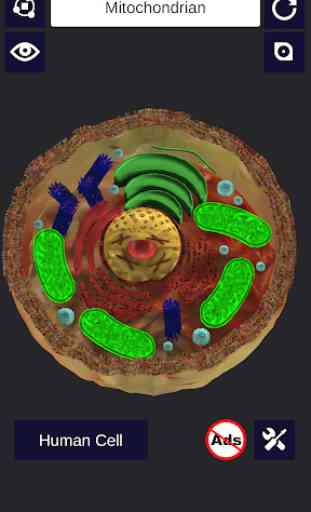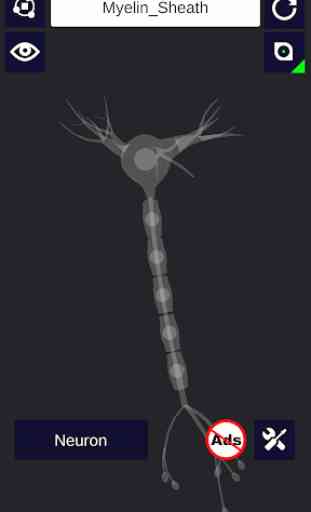3D Cell +
"3D Cell Interactive+" provides information and visualization on human cell, neuron, bacteriophage, prokaryotic cell and sperm cell through 3D models. A 3D interactive model helps to visualize the component. Models can be rotated, enlarged and a particular part of the system can also be focused to study.
Features:
1. Enable/disable any 3D object to see the parts behind it.
2. Information of each component is provided. Just click on any component and then click the "Heading Bar" to get information related to it.
3. In-detailed models.
4. 'Eagle Eye View' feature allows to view through the model, making it transparent. This helps you to understand the density of components in a particular region of that microscopic element.
5. Rotation and Scale Sensitivity of the 3d model can be controlled.
6. Other Mixed settings like illumination intensity can also be altered as per the users wish.
7. 3D Models and Information related to it are available in both Portrait and Landscape screen orientation.
Human Cell Components:
1. Centriole
2. Chromosome
3. Endoplasmic Reticulum
4. Cytoskeleton
5. Golgi Apparatus
6. Lysosome
7. Mitochondrion
8. Nucleolus
9. Nucleus
10. Plasma Membrane
11. Ribosomes
Neurons Components:
1. Nucleus
2. Dendrite
3. Axon
4. Myelin Sheath
5. Schwann Cell
6. Node of Ranvier
7. Axon Terminal
8. Synapse
Bacteriophage Components:
1. DNA
2. Capsid (Head)
3. Collar
4. Tail
5. Sheath
6. Base Plate
7. Tail Fibers
Sperm Components:
1. Acrosome
2. Axial Filament
3. Centrioles
4. Chromosome
5. Lysosome
6. Membrane
7. Mitochondrian
8. Nucleus
9. Nuclei
Prokaryotic Cell Components:
1. Chromosomal DNA
2. Capsule
3. Cell Wall
4. Cytoplasm
5. Plasma Membrane
6. Plasmid DNA
7. Ribosomes
Usage and Navigation:
1. Rotate the scene by dragging your fingers over the model.
2. Zoom the model in and out by pinching with your fingers.
3. Select the focus mode, and focus on a particular component. It will centre that component in centre of your screen.
4. Toggle check/uncheck the component to enable/disable them.
5. Reset the camera to get the initial view of the model.
6. RAM of your Android phone:
a) Recommended: 1GB
b) Minimum: 500MB
Note: Currently, the app is in English language only.
This is a must have app for biology/science students and high school students who are interested in learning about cells.
Update: The Future update will have many other Microscopic Components necessary for important understanding of Microscopic elements.
Features:
1. Enable/disable any 3D object to see the parts behind it.
2. Information of each component is provided. Just click on any component and then click the "Heading Bar" to get information related to it.
3. In-detailed models.
4. 'Eagle Eye View' feature allows to view through the model, making it transparent. This helps you to understand the density of components in a particular region of that microscopic element.
5. Rotation and Scale Sensitivity of the 3d model can be controlled.
6. Other Mixed settings like illumination intensity can also be altered as per the users wish.
7. 3D Models and Information related to it are available in both Portrait and Landscape screen orientation.
Human Cell Components:
1. Centriole
2. Chromosome
3. Endoplasmic Reticulum
4. Cytoskeleton
5. Golgi Apparatus
6. Lysosome
7. Mitochondrion
8. Nucleolus
9. Nucleus
10. Plasma Membrane
11. Ribosomes
Neurons Components:
1. Nucleus
2. Dendrite
3. Axon
4. Myelin Sheath
5. Schwann Cell
6. Node of Ranvier
7. Axon Terminal
8. Synapse
Bacteriophage Components:
1. DNA
2. Capsid (Head)
3. Collar
4. Tail
5. Sheath
6. Base Plate
7. Tail Fibers
Sperm Components:
1. Acrosome
2. Axial Filament
3. Centrioles
4. Chromosome
5. Lysosome
6. Membrane
7. Mitochondrian
8. Nucleus
9. Nuclei
Prokaryotic Cell Components:
1. Chromosomal DNA
2. Capsule
3. Cell Wall
4. Cytoplasm
5. Plasma Membrane
6. Plasmid DNA
7. Ribosomes
Usage and Navigation:
1. Rotate the scene by dragging your fingers over the model.
2. Zoom the model in and out by pinching with your fingers.
3. Select the focus mode, and focus on a particular component. It will centre that component in centre of your screen.
4. Toggle check/uncheck the component to enable/disable them.
5. Reset the camera to get the initial view of the model.
6. RAM of your Android phone:
a) Recommended: 1GB
b) Minimum: 500MB
Note: Currently, the app is in English language only.
This is a must have app for biology/science students and high school students who are interested in learning about cells.
Update: The Future update will have many other Microscopic Components necessary for important understanding of Microscopic elements.
Category : Education

Related searches
Reviews (14)
Aja. a.
Sep 7, 2019
Very informative app.I like this app
A. G. u.
Jun 16, 2018
This is very Excellent .If it is possible,i want to deep study and learn my mother tung telugu .
SAU. R.
May 8, 2018
improve it by proper labelling,give deeper level.
Jua. L. V.
Aug 27, 2018
Awesome hope to get along with the ad's,
Sai. G.
May 3, 2018
Amazing best way to learn
baa. b.
Mar 11, 2018
It is very great.
Nee. W.
Jun 21, 2018
Very good app especially if you want to study every type of cell. I also has a detailed explanation of all parts and organelles.
A. G. u.
Aug 17, 2018
Wow! Incredible app. So understandable that one could write his/her own answers after reading 5 seconds a topic.
A. G. u.
Aug 20, 2018
This is so cool i lern biology in very short wway👌👌👌👌
A. G. u.
Apr 29, 2018
Plant cell and vacoule in animal cell us missing.
Mon. K.
Feb 7, 2018
It is very great
A. G. u.
Apr 24, 2018
Its amazing
ans. d.
Jan 27, 2018
Actually the App is downloading





Very important and interesting for all ages .